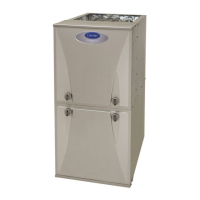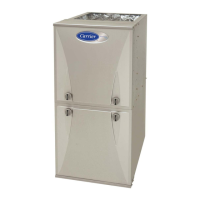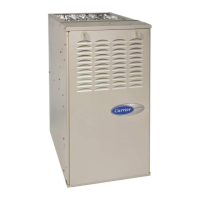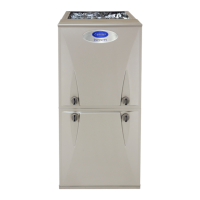PG96MSA: Installation, Start-up, Operating and Service and Maintenance Instructions
Manufacturer reserves the right to change, at any time, specifications and designs without notice and without obligations.
52
FURNACE CONTROL PROGRAMMING
AND NAVIGATION
On-Board Control Method
This furnace model is equipped with an on-board 3-digit LCD display
with pushbutton navigation for the adjustment of operating parameters,
diagnostics, and service. The control board must be powered to use the
display and pushbuttons. Upon startup, the control will alternate
displaying the Model Program Number (PRG) and Software Version
(uEr). The control board has been programmed at the factory with a
Model Program Number specific to the furnace product number. The
correct Model Program Number is shown on the furnace rating plate.
The system’s status is displayed after startup or after no control buttons
have been pressed for 60 seconds. Status Code LED will also be
illuminated or blinking when displaying the system status. The codes
which indicate the current operating mode of the system as shown in
Table 20.
The Main Menu provides access to operating parameters of the furnace
control including airflows as well as other diagnostics. See Fig. 37 for
the location of the pushbuttons. Scroll through Main Menu by pressing
MENU/SELECT button. Press NEXT/OPTION to display the current
setting of the parameter (value will flash). Additional presses will scroll
through setting options. Press MENU/SELECT button to save a new
setting and return to the Main Menu. The display will flash three times to
confirm a new setting selection has been saved. Fig. 58 shows the flow
of the menu and settings. Table 21 provides additional information on
parameter adjustment and applicability.
NFC and Supported App Method
This furnace control board is also equipped with NFC (Near Field
Communication) technology which allows the adjustment of operating
parameters, diagnostics, and service via a field-supplied mobile device
with NFC capability and supported mobile app. Remove 115-V power
from the furnace control board to use this method. See Fig. 37 for the
location of the NFC antenna. Additional instructions and help may be
available through the supported mobile app.
Scan the mobile app QR Code on page 1 of this manual for more
information and a link to download the mobile app.
CAUTION
!
ELECTRICAL SHOCK HAZARD
Failure to follow this warning could result in personal injury, or death.
Blower access door switch removes 115-V power to control. No
component operation can occur unless switch is closed. Caution must
be taken when manually closing this switch for service purposes.
Do not tape or permanently allow the door switch to be bypassed.
Temporarily depress the door switch with one hand while accessing the
service buttons with your other hand. Do not touch uninsulated
electrical components.
Table 20 – System Status Display Codes
Display Operating Mode Notes:
iDl
Idle/Standby Mode No active demands
Ht
Heating Mode Gas Heating active
CL
Cooling Mode Cooling or Heat Pump active
Hpd
Heat Pump Defrost Mode Gas Heating cycle active during Heat Pump Defrost cycle
Cfn
Continuous Fan Mode Continuous Fan active
bLr
Secondary Unit Operating
Blower
Only used when control is the secondary furnace of a twinned furnace system and primary
furnace is active
##.# Active Status Code See Fig. 59 or Furnace Service Label for codes
Table 21 – Main Menu Options
Display Operating Mode Use
FLt
Last 7 faults that occurred
Faults code menu stores the 7 latest faults in memory. If no faults, None (
non) will be
displayed. To clear fault history, scroll to Clear (
Clr) and press MENU/SELECT. See Fig. 59
or Furnace Service Label for codes.
Ht
Heating blower speed
Heating Airflow Setting. Adjust higher to lower Temp. Rise; lower to increase Temp. Rise. See
Start-Up Procedures. See Fig. 58 for allowable selections and Table 18 for airflows.
CL
Cooling and Heat Pump
blower speed
Cooling Airflow Setting. See Fig. 58 for allowable selections and Table 18 for airflows. Refer to
cooling or heat pump equipment data for required airflow settings.
Cfn
Constant Fan blower speed
Constant Fan Airflow Setting. See Fig. 58 for allowable selections and Table 18 for airflows.
HoD
Heat OFF Delay
Value shown in seconds. Shorter delays may leave unused heat in ducts. Longer delays may
blow cold air at the end of heating demands.
Cod Cool OFF Delay
Value shown in seconds. Shorter delays may leave unused energy in furnace coil. Longer
delays may re-evaporate condensate.
dir
Direction
Adjusts display orientation 180 degrees between up flow (
UPF) and down flow (dnF).
tnn
Twinning
Primary (
Pri) or Secondary (SEC) furnace selection. Adjust only if furnace is used in a
twinned furnace system. Use of accessory kit required. See kit instructions.
inF
Program # and Software
Do NOT program the control board with a Model Program Number different than what is
specified on the rating plate. Alternates displaying the saved Model Program Number (
pRG)
and Software Version (
uEr).
Ct
Component Test
Use to validate components are functioning as intended. See Component Self-Test
instructions in the Start-Up Procedures section.
rSt
Reset
Reset settings to Factory Default by selecting Yes (
YEs).

